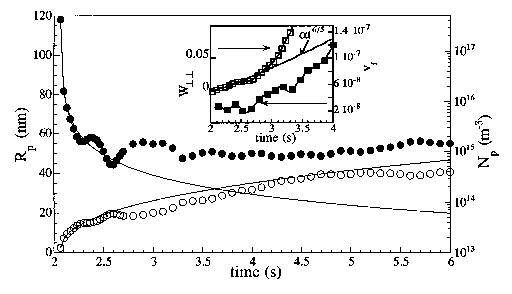Q2. What contributions have the authors mentioned in the paper "Particle agglomeration study in rf silane plasmas: in situ study by polarization-sensitive laser light scattering" ?
To determine self-consistently the time evolution of particle size and their number density in situ multi-angle polarization-sensitive laser light scattering was used. Later in the particle time development both techniques reveal spherical particles again. It is found that the particle radius and particle number density during the agglomeration phase can be well described by the Brownian free molecule coagulation model. Application of this neutral particle coagulation model is justified by calculation of the particle charge whereby it is shown that particles of a few tens of nanometer can be considered as neutral under their experimental conditions. The measured particle dispersion can be well described by a Brownian free molecule coagulation model including a log-normal particle size distribution.
Q3. What is the effect of the agglomeration on the electron density?
The charges on the large particles only influence the electron density considerably for low values of ni , since then the number of charges localized on these large particles becomes comparable to the ion density.
Q4. How can the authors solve the indetermination problem of four unknown quantities?
To solve the indetermination problem of four unknown quantities (Rp ,Np ,mr ,mi) from three independent measurements ~W'' , W ii , and T/T0!, the scattering angular dissymmetry method can be used.
Q5. How long does the distribution of particles remain in the discharge?
It should be noted that small size particles of about 40 nm remain in the discharge all along the time development, whereas large particles increase in size with time.
Q6. What is the effect of the large particle number density of very small particles?
The large particle number density of very small particles is responsible for a drastic decrease of the electron density in spite of the low number of charges attributed to each particle.
Q7. How many TEM grids can be exposed to the plasma during a certain time?
Twelve TEM grids can successively be exposed to the plasma during a certain time, through a 3 mm hole positioned 43 mm off electrode axis.
Q8. What is the advantage of the polarization-sensitive laser light scattering with respect to circular?
The advantage of the polarization-sensitive laser light scattering with respect to circular polarization methods21 is the sensitivity to the crosspolarization intensity.
Q9. What is the particle size distribution of the nonspherical cluster?
if each of the small particles constituting an agglomerate is counted separately instead of considering the nonspherical cluster as a single particle with a radius calculated from the sum of the volume of individual sticking particles in the agglomerate, this will lead to a bimodal size distribution.
Q10. How many nanometers of particles can be considered as neutrals?
Therefore particles in the order of up to a few tens of nanometers behave under their conditions like neutrals, at least at the beginning of the coagulation phase.
Q11. How long does the geometric standard deviation of the distribution function go?
it has been shown that for long times into the coagulation phase the geometric standard deviation approaches s51.35 independently of its initial value.
Q12. What is the particle number density in the agglomeration phase?
At the beginning of this agglomeration phase particles as small as a few nm are present in the plasma with a particle number density
Q13. What are the forces that are not taken into account in the BFMC model?
In this simplified model forces such as the van der Waals attractive force, the Coulomb repulsive force, and the laminar shear effect are not taken into account.
Q14. What is the physics of the agglomeration in dusty plasmas?
More sophisticated neutral coagulation schemes, including increasing charging of the particles with time and coagulation between charged and uncharged particles, may be necessary to understand in detail the physics of the agglomeration in dusty plasmas.
Q15. What is the effect of agglomeration on the plasma?
According to this, the authors can say that agglomeration ‘‘saves’’ the plasma from extinction by decreasing the net total charge on the particles.
Q16. How did the authors measure the scattering intensities at three angles?
For their measurements of the scattered intensities at three angles ~45°, 90°, and 135°!, the authors used the same iterative method as applied for one angle to determine the time development of the radius and the number density of particle.
Q17. What are the two explanations for the scattering of particles?
Two explanations can describe this phenomena, evaporation of the particles by the laser beam and/or the thermophoretic effect caused by a temperature gradient between the laser path and the rest of the plasma.
Q18. What could be the main reason for the misinterpretation of the measurements?
A supplementary study was devoted to the laser fluencepowder interaction which, it was found, could also lead to misinterpretation of the measurements.
Q19. What angle was chosen to estimate the multiple scattering intensity?
Placing the detectors just above the laser path allowed to estimate the multiple-scattering contribution which did not exceed 5%–10% of the direct polarization intensity.





